From Tramp Trades to Passenger Ro-Ros
One of my earliest recollections of Albert Edward Dock at North Shields in the early 1950s was watching with my father the unloading of pitprops from Rex Line steamers into railway wagons. My father was manager of the nearby Whitehill Point Staith, opened in 1953 to ship coal from the dozens of collieries to the north of Wallsend and Newcastle. The last collieries to close were Rising Sun colliery in 1969 and the Havannah, Brenkley and Hazelrigg collieries in 1974, with Whitehill Point Staith closed at the end of 1974 when my father retired. The staith had shipped well over one million tonnes of coal each year during its 21 years of operation. One of the onerous outdoor tasks of the Albert Edward Dock office staff was the annual ‘measuring up’ of the piles of pitprops that covered 250 acres of dock estate land to give an estimate of stored pitprops ready to be used in the shoring up of tunnels and shafts of the collieries. Some of the Baltic traders arriving in the Tyne with deck cargoes of timber had pronounced or severe lists to port or starboard, due to shifting cargoes made worse by immersion in seawater.
During the years of 1937 and 1938, 280,000 tonnes of pitprops and timber were imported at Albert Edward Dock, with two Rex Line vessels, Dalarö and Bjorkö, completing discharge on 31st October 1938, and then moved upriver to back load with a total of 9,600 tonnes of coal at Jarrow Staiths and Dunston Staiths. Timber and pitprop imports at North Shields reduced to 200,000 tonnes in the years of 1947 and 1948, and only 95,000 tonnes in 1962. Similar amounts of pitprops and timber were imported to Tyne Dock on the south side of the river for the Durham collieries. In addition to pitprops, sawn timber, deals, battens and boards, some 33,000 tonnes of mahogany and other hardwoods from West Africa were also imported in 1962 to manufacture veneers and plywood. There were two timber berths on the south side of Albert Edward Dock, with electric luffing cranes of up to forty tonnes capacity, which discharged the pitprops to railway wagons. They were left in their discharging slings while being taken to the storage areas, and instead of being stored unsorted, were sorted and placed in long piles by size as required.
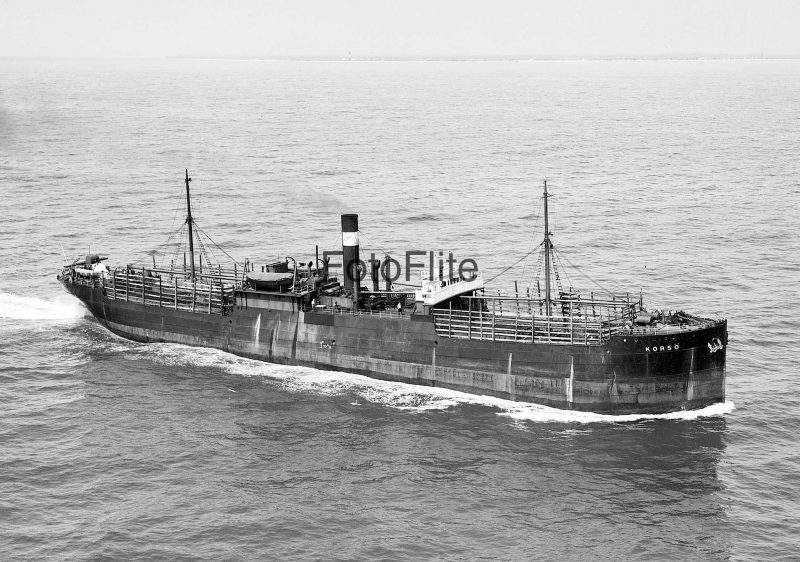
Rederi A/B Rex
The Rex Line steamers in the early 1950s were all engines ‘midships ‘three island’ types with high counter sterns bearing the names of islands in the Stockholm archipelago, all ending in ‘O’ with two small dots above and pronounced as a ‘U’. The archipelago covers an area of ninety miles from north to south and around twenty miles east of the capital. The inhabited islands number only 150 out of a total of 30,000 islands and islets, with many of the local population having summer houses here. Alö, Blidö, Dalarö, Gallnö, Lidingö, Ljusterö, Namdö, Runmarö, Smadalarö, Svartsö, Tyresö and Utö are some of the bigger islands with excellent sandy beaches for swimming in the warmer weather. Utö has a history dating back before the Viking era, with iron ore mining over a century ago, and today is the best seaside resort in the Stockholm archipelago.
Rederi A/B Rex had two periods of shipowning, the first was set up in 1903 by Waldemar Beijer in Stockholm with the first small steamer being Nord of 1,843 grt built by the Grangemouth and Greenock Dockyard in 1900 as Maria Goriainova. A larger Nord of 2,204 grt followed in 1906 from the Kockums yard with a quarterdeck of length 76 feet on an overall length of 280 feet. Tord of 1,313 grt was completed in August 1907 by the W. Harkess & Sons Ltd. yard at Middlesbrough with a bridge deck of length 136 feet, and Waldemar of 1,635 grt was purchased a few years later, having been built in 1908 by the Nordseewerke yard at Emden as Anna Podeus. Four Baltic traders were owned on the outbreak of World War I, the last two including Tord were sold off in 1917.
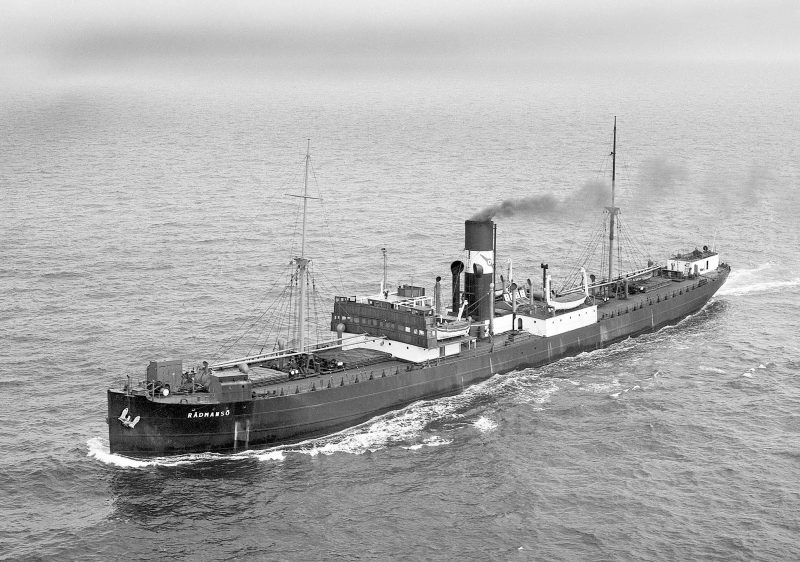
The second period of shipowning began in 1923 with Waldemar Beijer as shipowner and Knut Malkolm Kallstrom as managing director. Knut had previously worked with Beijer from 1906, and the Kallstrom family remained as Chairmen and Managing Directors of Rederi A/B Rex until the company was taken over by Salen in 1967. The fleet specialised in transporting iron ore from Lulea and Oxelosund to German and British smelters. The steamer Aspö of 1,397 grt, completed in May 1920 at the Malmo yard of Kockums, was the first steamer in the second fleet in 1923. She had dimensions of length 235.5 feet, moulded beam of 37.7 feet, and depth of 16.5 feet, with a fo’c’stle of length 25 feet, bridge deck of length 63 feet, and poop of length seventeen feet. Two further Baltic traders joined in 1924 as Elgö of 1,888 grt completed in October 1918 as Elsa by the Lindholmens yard, and Ornö of 1,474 grt completed by Kockums at Malmo in July 1924.
In 1933, the fleet strength was seven ships, the largest being the tramp Dalarö of 6,260 dwt which had been purchased in 1930 as Siljan but had been completed in 1911 by the Sunderland yard of Sir John Priestman as Vard. The other six Baltic traders were Aspö 1,397/20, Bjorkö 2177/24, the former Phyllis Seed of the Seed Shiping Co. Ltd. of Newcastle, Elgö 1,888/18, Ingarö 1,995/16, Runmarö 2,916/12 and Utö 1,444/14. Ingarö and Utö had been built as Denpark and Holmpark for J. & J. Denholm but had been purchased in 1926/27 from Merrett Brothers of Cardiff as River Dart and River Teign. Runmarö 2,887/12 had been completed as Confield for E. J. Sutton & Company of Newcastle by the Gray yard at Hartlepool and was purchased in 1929, and was a typical ‘three island’ ship of length 314.0 feet and beam of 46.6 feet and suitable for most tramp cargoes including Baltic timber. Another member of the E. J. Sutton & Company fleet was purchased in 1939 and renamed Korsö, but had been built on the Tyne by Swan, Hunter & Wigham Richardson Ltd. as Gracefield in 1905. She completed a 56 year career when she arrived as Korsö at Ystad in Sweden for breaking up in January 1961.
A larger Rex Line fleet of fifteen ships was owned on the outbreak of World War II in Aspö 1,397/20, Bjorkö 2,177/24, Dalarö 3,927/11, Elgö 1,888/18, Granö 1,890/20, Ingarö 2,010/16, Korsö 2,771/05, Ljusterö 3,658/19, Radmansö 4,265/14, Runmarö 2,887/12, Sandö 1,334/02, Torö 1,467/24, Tynningö 4,265/14, Utö 1,444/14 and Varmdö 3,536/01. The larger tramps traded to the Plate and loaded grain at Rosario for European ports, the others operated in the Rex Line Baltic iron ore and timber trades. Further ships were purchased between 1940 and 1942 to transport iron ore in German convoys from Lulea and Oxelosund to German ports. These included Edö 1,407/23, Eknö 1,820/16, Fogdö 1,853/25, Lidingö 5,842/17 and Vindö 2,335/09. The latter vessel was a Doxford ‘Turret’ ship built as Inland for A/B Tirfing (Axel Brostrom, manager) and was purchased in 1942 from Finnish owners as Ulla and renamed Vindö. She survived the war and completed a useful career of fifty years under Rex Line ownership before arriving at a Ystad shipbreakers yard in Southern Sweden in 1959.

Rex Line, as with all Swedish shipping companies, prospered from neutrality during World War II, but lost ships to both German and Allied forces including:-
- Torö mined and sunk on 12.12.1939 off Falsterbo in Southern Sweden while on a voyage from the Tyne to Malmo and Ronnskar with 1,770 tonnes of quartz.
- Dalarö torpedoed and sunk by U53 on 12.2.1940 when 94 miles SE of Rockall while on a voyage from Rosario to Malmo with grain and bagged linseed, Master lost but crew saved.
- Varmdö bombed and sunk by British aircraft on 30.5.1942 off Terschelling while on a voyage from Vasteras to Rotterdam with iron ore in a German convoy.
- Eknö mined and sunk between Heligoland and Bremen on 21.6.1942 while on a voyage from Lulea to Bremen with iron ore.
- Lidingö mined and sunk off Rostock on 6.11.1942 while on a voyage from Lulea to Emden with iron ore.
- Tynningö mined and sunk on 7.9.1942 off Borkum on the German North Sea coast while carrying iron ore from Lulea to Rotterdam, her crew of 32 were saved.
Rex Line In Post-War Years
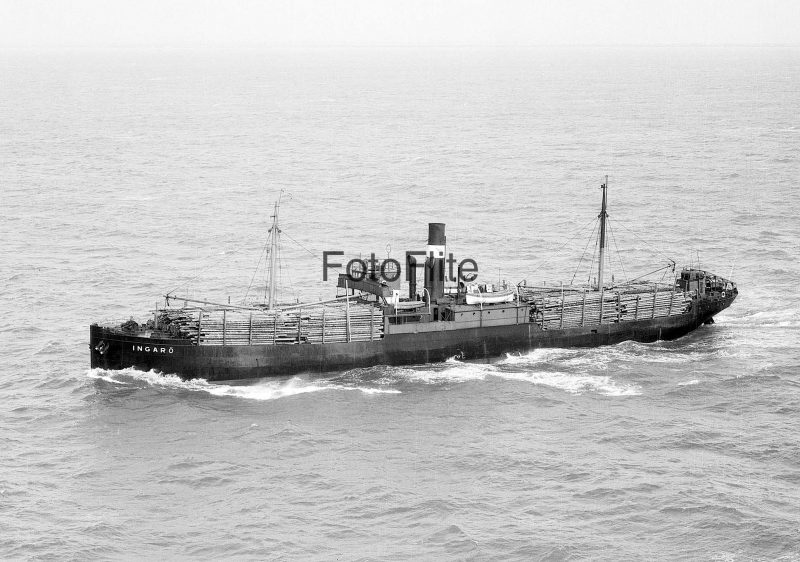
During the post-war period from 1946 to 1960, the shipbrokers Ivar Lundh & Company A/B of Stockholm acted as house brokers for Rederi A/B Rex, and concluded many time charters, ‘spot’ charters, and contracts of affreightment for up to ten years in the timber, coal, coke and iron ore trades. The big World War I standard tramp Resarö of 8,250 dwt was chartered for four years from 1951 to 1955 to carry iron ore from Lulea into Tyne Dock as well as into the Wear for the Consett Iron Co. Ltd. She carried the last ever cargo of iron ore into the South Dock at Sunderland on 24th October 1953, and from this date all shipments were made into the Tyne.
By 1950/51, the Rex Line fleet had been built up to two dozen ships in a replacement programme of both new and second hand ships, including two hulls that had lain incomplete during the latter part of the war at the Oskarshamns Varv A/B yard in Sweden, completed as Musko and Skarpo. This big fleet comprised the ships:-
| Angsö | 1,865/23 | Lovö | 1,285/48 |
| Aspö | 1,331/20 | Muskö | 3,607/46 |
| Bjorkö | 2,258/24 | Radmansö | 4,265/14 |
| Bullerö | 4,693/39 | Ramsö | 2,916/07 |
| Edö | 1,407/23 | Ranö | 2,018/47 |
| Fogdö | 1,853/25 | Resarö | 5,194/18 |
| Granö | 1,890/20 | Runmarö | 2,887/12 |
| Harö | 1,978/49 | Skarpö | 3,555/48 |
| Hogmarsö | 5,148/20 | Svanö | 2,034/23 |
| Ingarö | 2,010/16 | Tyresö | 3,722/20 |
| Korsö | 2,771/05 | Utö | 1,444/14 |
| Ljusterö | 3,658/19 | Vindö | 2,335/09 |
The biggest tramps were Hogmarsö of 9,390 dwt and Bullerö of 8,850 dwt, the former Sydland and Hemland of A/B Tirfing (Axel Brostrom, manager), as well as Resarö of 8,250 dwt, the former War Lark and Turkistan of Strick Line, and Radmansö of 7,790 dwt, the former Nordic of Rederi A/B Transatlantic (G. Carlsson, manager). They were engaged on the Swedish iron ore trade from Lulea and Oxelosund to British and German ports, the coal out grain homewards trade to the Plate, and on worldwide tramp trades. Hogmarsö had been built by the Doxford yard at Sunderland in 1920 as Sydland for A/B Tirfing (Axel Brostrom, manager) and was purchased by Rex Line in 1948 and renamed. She was sold in 1957 to a Bermudan company and renamed Caymont and arrived at Rotterdam for breaking up on 9th June 1958 after a career of 38 years. Resarö had been built as War Lark in 1918 by the Earle yard at Hull and became Turkistan in the following year, and was purchased by Rex Line in 1951. She was sold on four years later and ended her days at a scrapyard in Osaka in September 1960 after a career of 42 years.

Lovö was the first motorship in the fleet as she was given a six cylinder two stroke single acting Atlas diesel engine during fitting out at the Ekensberg Varv shipyard at Stockholm. Bjorko was sunk in a collision on 6th November 1953 with the steamer Sea Wind when three miles north of the Weser Light Ship while on a voyage from Vesteras to Ijmuiden with ore and sank with the loss of seven crew members. Tyresö had been built at Walker on Tyne by the William Dobson yard in 1920 as Rio Grande for Det Nordenfjeldske of Trondhim, and was purchased in 1949 as Victoria from Swedish Lloyd. She was traded for six years before her sale to Wallem & Company of Hong Kong, keeping her name for a few more years until she was broken up in Indonesia in 1970 after a useful career of fifty years. Ramsö was a typical Baltic timber carrier and had been built on the Tyne in 1907 by the Hebburn yard of Robert Stephenson & Co. Ltd. as Marina. She was purchased by Rex Line in 1951 and renamed, but after four more years of trading arrived at Ystad for breaking up on 29th September 1955 after a useful career of 48 years.
In the mid 1950s, the company embarked on a fleet renewal programme in the ore/oil trades with a fleet of ore carriers that could back haul to Sweden with oil. The first was Bjornö of 5,540 dwt with bridge ‘midships engines aft configuration, with a goalpost mast on the fo’c’stle, and dimensions of length 350 feet and moulded beam of 52 feet with a service speed of thirteen knots. She was followed from the same Howaldtswerke yard at Kiel by the all aft similar sized Lindö of 1957 and Rindö of 1960, and Singö of 1962, the latter with five holds and of 7,291 dwt. The ore/oil Rautas of 12,975 dwt, completed in 1938 by Gotaverken for Grangesberg, was purchased in 1962 and renamed Foglarö, and the former tanker Inge Maersk, completed by Odense shipyard in 1939 for Maersk Line, was purchased in November 1957 and converted to an ore carrier and renamed Tosterö. The bridge ‘midships engines aft ore/oil carrier Vindafjord of 12,360 dwt, completed in 1955 by Gotaverken for A/S Malmtransport of Oslo, was purchased in 1964 and renamed Ledarö for iron ore cargoes. She passed in 1975 to West German owners and was renamed Maxhutte and arrived at Setubal for breaking up which began on 15th June 1985.
The tramp Tordene of Dene Shipping Co. Ltd. and completed in 1936 by the Gray yard at Hartlepool was purchased in 1955 as Polyana from Rasmussen of Norway and renamed Saltarö. She was carrying Swedish iron ore from Oxelosund to Barrow when she grounded on Sheep Island in the Walney Channel leading to Barrow docks on 29th November 1956. The veteran steam coaster Anna Toop 421/93 was used to offload part of her cargo, but it was to no avail as her back was broken. The stern half was salvaged and taken into Barrow for unloading and scrapping, and the fore half also was later scrapped. The former Doxford Economy tramp Wearpool, completed in August 1936 for Ropner, was another British tramp that found its way into Rex Line ownership. She was renamed Adelsö in 1954, and was later sold on to Greeks to become Lefkipos and Dimitros before she arrived for scrapping at La Spezia on 20th October 1979 after a career of 43 years.
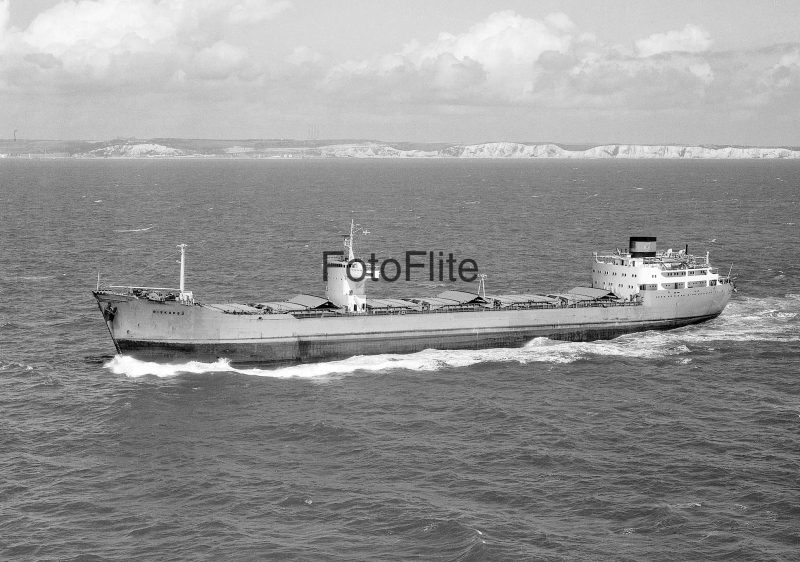
The ore carrier Biskopsö was completed in 1956 by the Kockums yard as Malmo as the second of three identical ore carriers for Swedish owners.
Cassiopeia of 19,300 dwt was completed in 1956 for Nordstrom & Thulin, while the third was completed as Atomena at Sunderland by Sir James Laing & Sons Ltd. The trio had six holds and were intended to carry Swedish or Labrador iron ore in winter before moving into other worldwide bulk trades in summer. The slim navigating bridge was positioned between numbers two and three hatches, and the modern crew accommodation was aft. The holds were self trimming and especially designed for the iron ore, coal and grain trades, and hydraulically operated hatch covers were fitted. A double skinned hull of length 536 feet, moulded beam of 70.6 feet and moulded depth of 44.3 feet gave a loaded summer draft of 31.8 feet. A service speed of fourteen knots was obtained from a Kockums M.A.N. eight cylinder two cycle diesel engine of 7,200 bhp.
The fleet in 1961/62 was still a large one of twenty two ships with seven ore/oil carriers and comprised:-
| Adelsö | 4,997/36 | Lagnö | 2,077/53 |
| Biskopsö | 13,670/56 | Lindö | 4,471/57 |
| Bjornö | 4,473/55 | Ljusterö | 3,658/19 |
| Bullerö | 4,767/39 | Ranö | 2,006/47 |
| Fogdö | 1,853/25 | Segerö | 4,552/62 |
| Foglarö | 8,966/45 | Singö | 4,822/62 |
| Harö | 1,978/49 | Siarö | 2,961/53 |
| Hasselö | 8,491/39 | Svanö | 2,034/23 |
| Husarö | 4,531/61 | Tosterö | 9,577/39 |
| Ingarö | 2,010/16 | Vettersö | 8,493/38 |
| Korsö | 2,782/05 | Vendelsö | 25,752/60 |
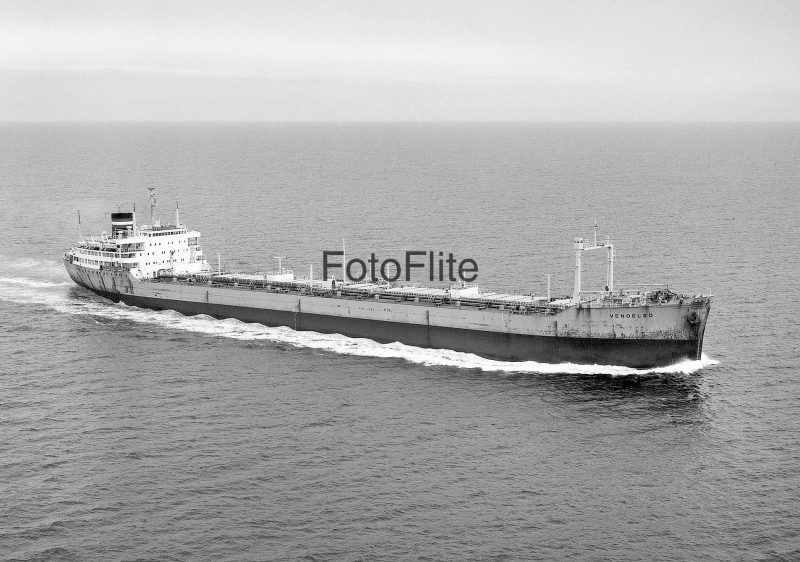

Vendelsö was a big ore/oil carrier of 38,675 dwt with a service speed of 16.5 knots on a summer loaded draft of 35.9 feet. She was completed by the Mitsubishi yard at Yokohama in 1960 and passed into the Salenrederierna fleet in 1967 as Sea Swallow, before being converted and widened into a pipelayer and crane ship in 1976 renamed as Sea Lion. She was sold to Mexican owners in 1981 and renamed Huasteco, and then became Sea Lion 1 in 2008 and was still in service in April 2016 in the oilfields of the Gulf of Mexico after a useful career of 56 years so far.
The last new ships completed for Rex Line were the two dry cargo sisters Husarö and Segerö of 9,429 dwt completed in 1961/62 by the Oskarshamns Varv yard. They had their engines aft of their four holds with a goalpost mast on the forward end and another just in front of the bridge, each with two derricks, plus two electric cranes ‘midships at the sides of the holds. A service speed of 14.75 knots was obtained from a six cylinder two stroke single acting diesel of 5,000 bhp. They were sold off in 1976, with Segero moving to the Caribbean for Inversiones Navieras Imparca of Puerto Cabello in Venezuela and renamed as Tiuna for ten years of more service before arriving at Recife in Brazil for scrapping as Rio Neveri on 13th November 1985.
The brothers Ragnar and Knut Kallstrom had taken over the management reins of the company on the death of their father Knut Malkolm Kallstrom in 1949. They became proactive in 1965 in changing the focus of the company away from ore carrying and tramping by purchasing the last two cargo-liners of Gustav B. Thorden Lines A/B of Uddevalla, with ‘Thorden’ as suffixes to their names. Furthermore, at the end of 1965, the Rex Line Group was formed with Transoil, a subsidiary of A/B Transatlantic managed by the Carlsson family of Gothenburg, to take over the fleet of Adolf Bratt & Company of Gothenburg, whose ships had names with a suffix of ‘Bratt’. Finally, in early 1967 the Rex Line Group was bought up by Salenrederierna of Stockholm. The last Rex Line dry cargo ships, the sisters Husarö and Segerö built in 1961/62 of 9,230 dwt with a summer loaded draft of 28.0 feet, kept their names but changed funnel colours to the blue of Salen with a white ‘S’. The ore/oil carriers of Rederi A/B Rex e.g. Foglarö, Ledarö, and Singö also kept their names but changed funnel colours until 1975, when Salen implemented a reorganisation and the Rex Line name disappeared after over seventy years of shipowning. A petition was later submitted on 19th December 1984 to the District Court of Stockholm for the winding up of Salenrederierna, which had been hard hit by the shipping crisis of the early 1980s.
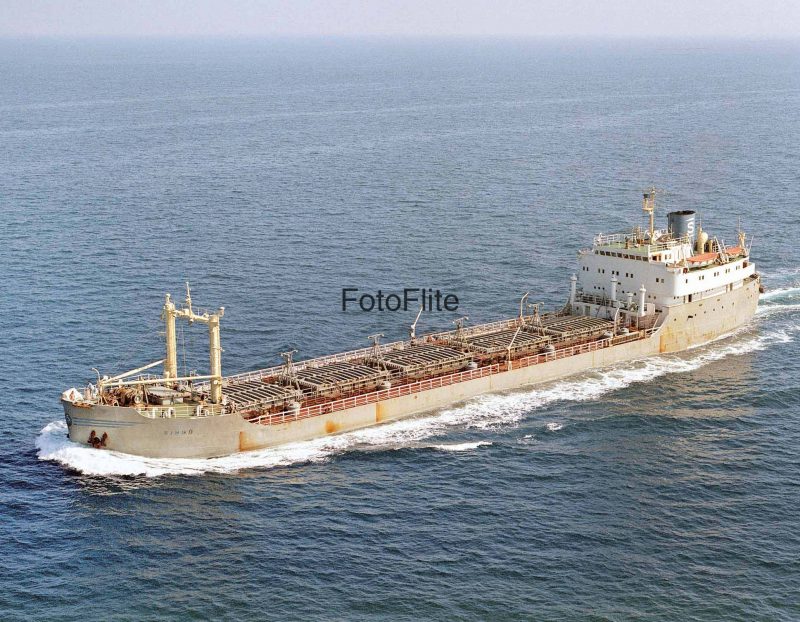
Tor Line A/B
In a move away from the tramp trades in 1965, Rex Line set up a jointly owned ro-ro operation with Transoil of Sweden (G. Carlsson of Gothenburg) called TOR Line, the name derived from both companies as TransOilRex. Two passenger ro-ros were ordered from the Lubecker Flender Werke yard at Lubeck for delivery in 1966/67 as Tor Anglia and Tor Hollandia for the Gothenburg to Immingham and Amsterdam route. They had accommodation for eight hundred passengers with the car decks holding 120 cars and 35 lorries. A high service speed of 22 knots was provided by four 12 cylinder Pielstick diesels with a combined output of 22,320 bhp. Tor Line became half owned by Salenrederierna in 1967 when Salen took over Rex Line.
Freight ro-ro services were begun in 1969 on the same route with Tor Mercia and Tor Skandia of 1,600 grt with their ro-ro deck holding sixty cars and 45 lorries. New routes were tried to Immingham from Halmstad, Rotterdam, Helsingborg, Copenhagen, Cuxhaven, Antwerp, Kristiansand and Brevik, as well as Gothenburg to Antwerp, Brevik and Ghent, and later from Copenhagen to Fredericia and also to Klaipeda in Lithuania. A much larger fleet of freight ro-ros was required, with six ordered from the Framnaes yard at Sandefjord in Norway able to transport 135 cars and 95 lorries. These were delivered as Tor Belgia (1971), Tor Gothia (1972), Tor Nerlandia (1972), Tor Dania (1973), Tor Finlandia (1974) and Tor Caledonia (1977), all of 4,168 grt and service speeds of 18.5 knots from Pielstick diesels from the Lindholmens yard.
The competition on the Hull to Gothenburg route was provided by three new passenger ro-ro ferries completed at the same time as Tor Anglia and Tor Hollandia. These were Saga, Spero and Svea running on the ESL (England Sweden Line) consortium of Swedish Lloyd, Ellerman Wilson Line and Svea Line. This trio had accommodation for 750 passengers but with a lower service speed of 18 knots. Tor Anglia and Tor Hollandia proved much superior with their higher speed, very modern and bright public areas, and full height car decks. The ESL service faltered after a few years, and ended in May 1975 with the delivery to Tor Line of the first of a pair of exceptional streamlined passenger ro-ros, Tor Britannia, followed by her exact sister Tor Scandinavia in 1976.
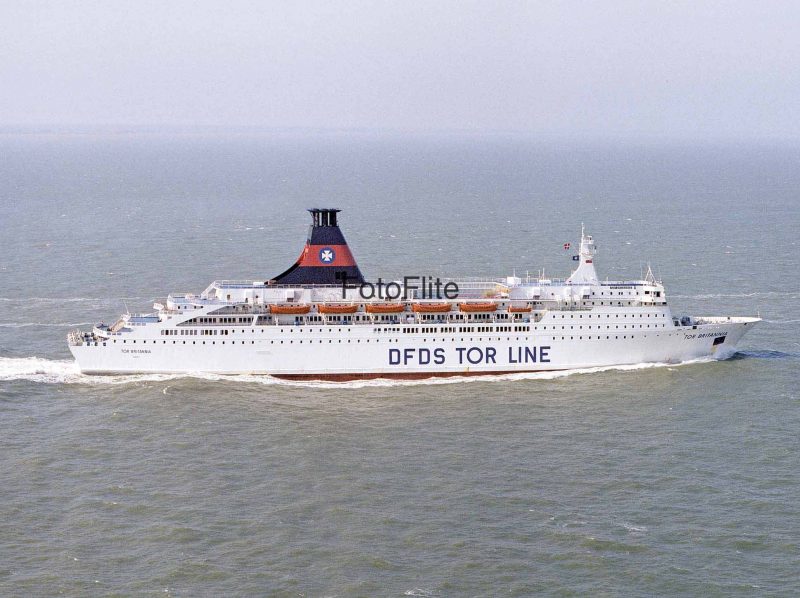
This pair were big, fast, and very comfortable, with very large public areas, restaurants and rooms, with the majority of overnight standard cabins located forward of ‘midships. They were built by the Flender Werft yard at Lubeck on dimensions of length 182.35 metres (591 feet), moulded beam of 23.63 metres (78 feet) and depth to upper deck of 16.1 metres (52 feet) with four passenger decks for a total of 1,532 passengers, with 845 of these in cabin berths. Twin screw passenger ships of 15,730 grt with service speeds of 24.5 knots from quadruple twelve cylinder Lindholmen Pielstick diesels, and room for 440 cars on their lower car deck, and costing £13 million each, this pair were the finest North Sea passenger ro-ros for the next two decades.
The superiority and popularity of Tor Britannia and Tor Scandinavia was undisputed on their busy summer North Sea schedule from Esbjerg and Gothenburg to Felixstowe and later Harwich, but it was a different matter in the rough months of winter on the North Sea. Passenger loadings were far too low, and Tor Scandinavia was chartered out in the winter months from 1979/80 onwards as an exhibition ship chartered to the Dutch ‘World Wide Expo’ organisation for European manufacturing companies to showcase their products. Tor Line needed additional capital, and this underlined the insecure and shaky nature of Tor Line finances, with short lived joint services tried with Sessan Line in 1980. Tor Line turned to DFDS of Denmark for discussions as a possible partner or buyer of one of the successful pair of Tor Britannia or Tor Scandinavia. DFDS responded by purchasing the entire Tor Line passenger division in late 1981 and the Tor Line freight operation a year later in 1982.
DFDS Tor Line later transferred Tor Britannia and Tor Scandinavia to the Newcastle to Gothenburg route in 1991 as Prince of Scandinavia and Princess of Scandinavia. Extra cabins were added and they were remeasured at 21,545 gt. Regular summer sailings from the Tyne to Gothenburg dated back to the 1970s, but all year round sailings by two fuel hungry high speed passenger ferries proved too much, with Tor Britannia sold to Moby Lines of Italy in November 2003 and renamed Moby Drea, and Tor Scandinavia sold to the same Italian ferry company three years later in November 2006 and renamed Moby Otta. The Tyne to Gothenburg service closed at this time, and as a matter of interest the two streamlined Tor Line passenger ferries were only ever seen together at North Shields on one occasion, this happened on 27th April 2001.
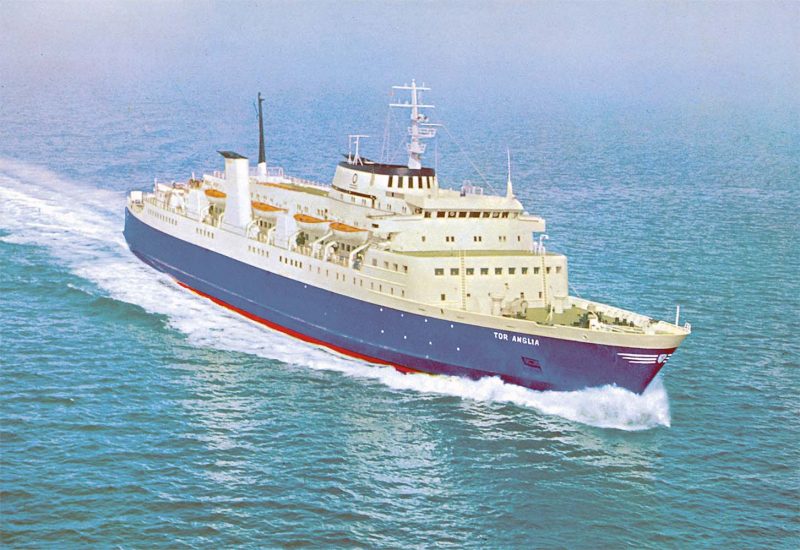
The DFDS Tor Line freight division achieved equal status with that of the DFDS Tor Line passenger division in 1986. DFDS Tor Line then markedly increased the number of chartered and purchased new and second hand tonnage for their big freight network. A large total of freight ro-ros included three chartered from 1981 and purchased in 1988 from Oden Line as Anna Oden (renamed Tor Flandria), Britta Oden (renamed Tor Scandia) and Eva Oden (renamed Tor Belgia). Ro-ros were frequently lengthened to cope with the increase in trade, two were purchased from Maersk Line in 1992 as Maersk Essex and Maersk Kent, and many other DFDS Tor Line ro-ros had originally been built for charter to Norwegian, Italian, French and Chinese shipping companies.
Tor Line ‘Bridge’ Services
The AngloBridge service of DFDS Tor Line from Gothenburg to Immingham began in 1995 with the opening of the DFDS Nordic Terminal at Immingham, and the concentration of all ro-ro freight shipping by Tor Line to the U.K. at Immingham and Harwich. The service has four main customers with long term agreements of up to ten years in Saab, Volvo Logistics, Stora Enso forestry products, and Avesta of Sheffield steel exports. Avesta exported 650,000 tonnes per year of steel slabs and coils from Immingham to the Alvesborg harbour in Gothenburg for rolling and shipping out to markets in the Baltic. The exported steel was contained in 120 specially constructed ‘cassettes’ to minimise damage and arrived by rail to the Immingham intermodal system. Stora Enso imports 800,000 tonnes per year of paper shared between Immingham and Harwich. The AngloBridge service was originally four times weekly and is now six times weekly in both directions using three ro-ro vessels. Ambitious targets in trailer throughput, land storage area and warehousing are constantly set for the Immingham DFDS Tor Line terminal with three shift 24 hour and seven day working, as there are, or have been, several other major North Sea competitors battling for their share of the Humber trade including Stena, Cobelfret, P. & O., and Norfolk Line. There are six ro-ro berths at Immingham with a terminal area of 720,000 square metres and a workforce of 600, with different systems used for the shipment of trailers, cars, paper and steel.
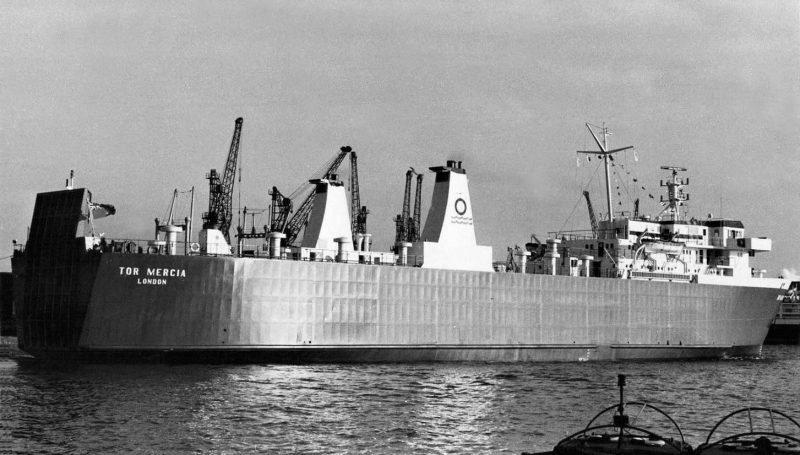
The AngloBridge South route from Gothenburg to either Harwich or Tilbury began in April 2005 with three sailings per week using Tor Selandia of lane length 2,800 metres and Tor Neringa of lane length 1,800 metres.
The EuroBridge service from Gothenburg to Ghent via Brevik began in 1998, and was originally four times weekly and is now six times weekly in both directions using three ro-ro vessels. The sisters Tor Flandria and Tor Scandia of 2,875 metres lane length were the first ro-ros on this important ‘Bridge’ route. Volvo Logistics are again one of the main customers, shipping 7,000 trailers per year in and out of Ghent for the European car market. DFDS Tor Line was shipping over five million tonnes of cargo per year from Gothenburg to Ghent, Immingham and other North Sea and Baltic ports, with up to forty sailings per week from Gothenburg in the busier times.
The NorBridge service from Immingham to Brevik began in November 1998 after DFDS Tor Line had acquired the Fred. Olsen North Sea Line. A main customer is paper manufacturer Norske Skog with 100,000 tonnes of paper shipped to the U.K. per year. The other DFDS Tor Line ‘Bridge’ services are BritanniaBridge from Harwich or Immingham to Esbjerg, ElbeBridge from Immingham to Cuxhaven, BalticBridge from Aarhus, Fredericia and Copenhagen to Klaipeda, and NevaBridge from Karlshamn and Kiel to St. Petersburg.

Six new owned ro-ros were delivered from the Flensburg shipyard during 2003/06 as Tor Begonia, Tor Ficaria, Tor Freesia, Tor Magnolia, Tor Petunia and Tor Primula with lane lengths of 3,900 metres to handle 280 trailers, with hull lengths just short of 200 metres. The DFDS Tor Line division profits were 37% higher in 2007 over the previous year, with the division providing 76% of total DFDS profits to make it the best performing division of DFDS. DFDS Tor Line had fifty chartered and purchased ro-ros in its fleet in 2010, double the number of twenty years previously, with the target of having half of the fleet as owned vessels having been achieved. This total included thirty owned ro-ros with an average age of ten years e.g. Tor Anglia, Tor Baltica, Tor Begonia, Tor Belgia, Tor Bellona, Tor Botnia, Tor Britannia, Tor Cimbria, Tor Corona, Tor Dania, Tor Ficaria, Tor Finlandia, Tor Fionia, Tor Freesia, Tor Flandria, Tor Futura, Tor Gothia, Tor Hafnia, Tor Hollandia, Tor Humbria, Tor Jutlandia, Tor Magnolia, Tor Minerva, Tor Norvegia, Tor Petunia, Tor Primula, Tor Scandia, Tor Selandia, and Tor Suecia. Chartered vessels included Aquae (the former Tor Cimbria), Ark Forwarder (the former Sea Centurion of the Royal Fleet Auxiliary), Envoy (the former Ibex of P. & O.), Vilnius and others.
In 2010, DFDS streamlined their freight operations of DFDS Tor Line, DFDS Lisco on Baltic services (taken over in 2001 and renamed in 2006), and Norfolk Line (taken over in 2009) into DFDS Seaways. Big changes and new routes meant an end to the historic name of Tor Line after 45 years of operation from 1965. The last quartet of DFDS Tor Line ro-ros had been completed during 2008/10 as Tor Corona, Tor Hafnia, Tor Fionia and Tor Jutlandia with quadruple the lane length of the original Tor Line sextet delivered from 1971 onwards. The new quartet could accommodate 260 full length trailers or 240 lorries and had service speeds of twenty knots, and were built in the Far East by the Jinling Shipyard at Nanjing in China. Tor Line disappeared into the realms of maritime history, just as its predecessor of Rex Line had disappeared in 1975. The Tor Line ro-ros lost their ‘Tor’ prefixes but gained ‘Seaways’ suffixes to their names e.g. Tor Petunia became Petunia Seaways, while the ro-ros Ark Futura 18,725/96, the former Tor Futura, and Ark Dania 33,313/14 are also in the present DFDS fleet.

Postscript
The funnel colours of Rex Line were black with a white central band bearing a blue compass needle tilted at an angle, and the houseflag was white with the same blue compass needle. The funnel colours of Tor Line were white with a black top and a logo of an outer thicker black circle encompassing a thinner black inner concentric circle, with two blue wavy lines underneath. The latter colours were changed when DFDS Tor Line was formed to a dark blue funnel with a white Maltese cross. However, the names of Rex Line and Tor Line, in their very contrasting trades of tramping and passenger and freight ro-ro trades, had endured for over a century from 1903 to 2010. The twin main staples of Rex Line, timber and iron ore, are still very much in production today in Sweden, with 70 million cubic metres of sawn logs, veneer logs, railway sleepers, pulp wood, fuel wood and industrial wood, 8.5 million cubic metres of newsprint and paper, and twelve million tonnes of iron ore mined per year. These commodities are exported from the principal ports of Gothenburg, Stockholm, Brofjorden, Trelleborg, Lulea, Oxelosund and Malmo. Brofjorden lies on the only fjord in Sweden on the west coast near Uddevalla, whose great shipyard closed in the 1980s after completing several VLCC tankers.
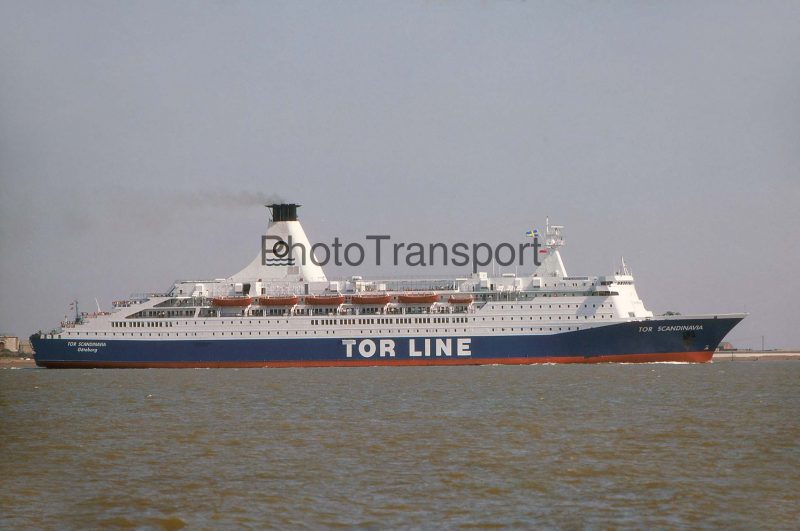
The Tor Line passenger ferries Tor Anglia and Tor Hollandia had been sold off in 1975/76 when the much bigger and faster Tor Britannia and Tor Scandinavia came into service. Tor Anglia was sold for Western Mediterranean services, becoming Espresso Olbia and then Sardinia Nova in 1982 and Baia Sardinia in 2006 for services to Sardinia from Genoa and Salerno. Tor Hollandia was sold to Minoan Lines and was renamed Ariadne for services from Piraeus to Crete, and then was sold in 1999 to Fragline Ferries to be renamed Ouranos. The pair had moved into Turkish waters by 2010, with the former Tor Hollandia sold for breaking up there, but the former Tor Anglia escaped the same fate as she was resold for use as an accommodation ship at Azganik in Turkey. Tor Britannia and Tor Scandinavia are still in service today in the Western Mediterranean for Moby Lines, with very garish blue, orange and other coloured hull graphics together with a large blue whale and blue ‘MOBY’.
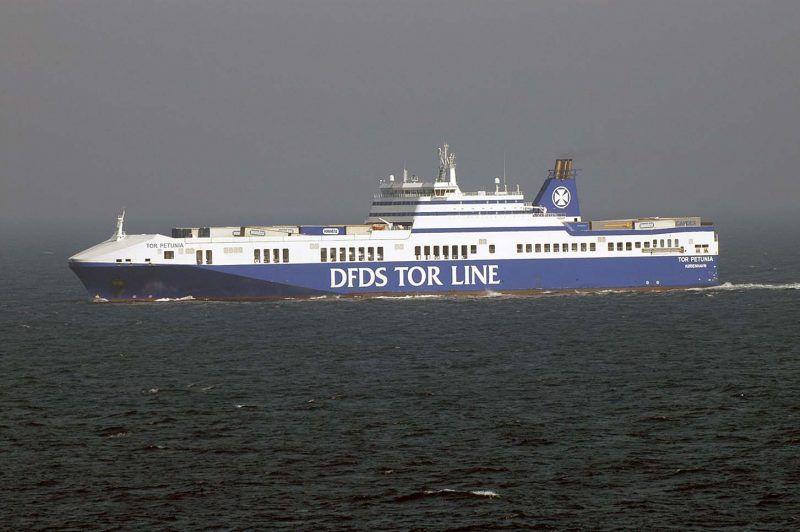

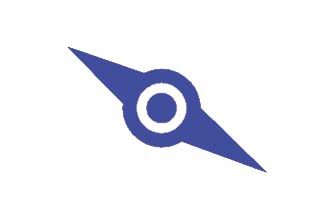
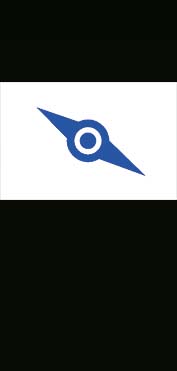
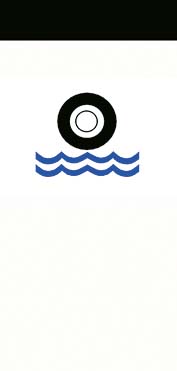
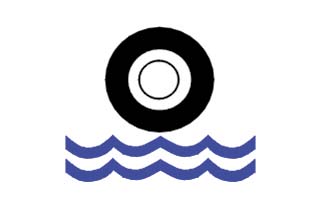

Comments
Sorry, comments are closed for this item